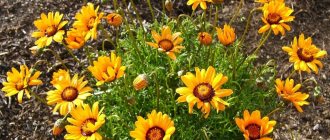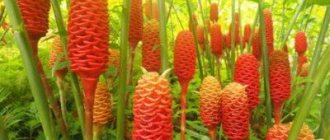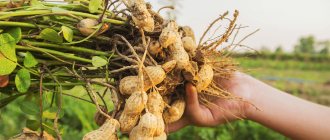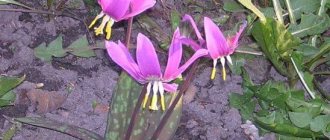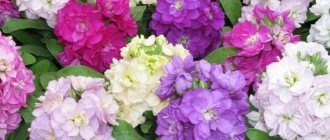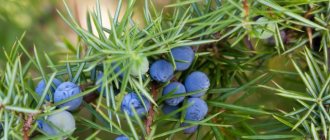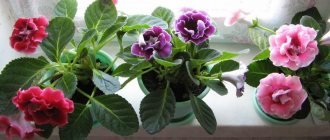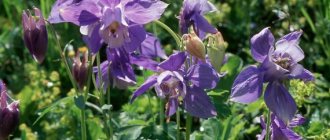Low herbaceous plants with lush greenery and bright flowers are Torenia. The buds have an original shape, reminiscent of an Orchid or Gloxinia, but the size of the flowers is smaller. Plants decorate cottages, gardens, flower beds near houses, balconies, terraces and loggias.
Where to plant an annual? What soils does Torenia prefer? Growing and care, preparing seedlings, choosing the right variety, disease prevention, descriptions and photos, advice from experienced gardeners - interesting and useful information for fans of bright colors and green decor.
Description of Torenia
Torenia is one of the most striking and special flowering annuals. With a maximum height of 30 cm, torenia forms lush and very beautiful bushes from branched creeping shoots and alternately arranged elegant simple leaves with a solid edge, with its own prominent veins, pointed tip and very bright color.
The flowering of torenia is called a royal spectacle. Graceful asymmetrical velvet bells with a cone-shaped corolla and a bright spot on the lower lip are scattered throughout the bush like little watercolor treasures. The combination of colors - white, yellow, blue, lilac, pink, dark violet, purple - seems even more variegated due to the texture. Torenia blooms all summer. After flowering, oblong multi-seeded fruit capsules are formed.
Of the 50 species of torenii, which are all interesting plants without exception, less than a dozen plants are used in landscape design. The most popular Fournier torenii (dark purple, coarse-haired and yellow) differ in decorative details, but they have exactly the same requirements for care and cultivation.
All annual garden torenias are grown mainly from seeds and only by seedlings.
Outdoor care
A fairly unpretentious torenia plant develops well in partial shade and moderate lighting. The “transparent”, sparse crown of trees on the site does not interfere with abundant flowering and, at the same time, prevents the harmful effects of the scorching sun.
The main measures for caring for herbaceous annuals: moistening the substrate, adding organic matter and minerals, loosening, weed control, mulching. Transplantation of an annual species is not carried out unless there are serious indications, for example, infected plants have appeared on the site: a virus, fungus, dangerous bacteria.
Watering
Short periods of drought are less harmful to torenia than clayey, dense substrates and islands of water near the bushes, but it is more useful to stick to the golden mean. The soil is moistened as the top layer dries, taking into account the volume and frequency of precipitation. Water the plants quite often, but the amount of liquid is moderate.
Important details:
- During the release of buds, you need to carefully monitor the level of soil moisture: if the substrate is very dry, the flowers often wither and fall off, or the bright colors please the eye for a shorter period.
- When watering, proceed carefully: use a watering can with a long, narrow spout so that drops do not fall on the buds and leaves.
- Do not add cold liquid to the substrate.
- Infrequent loosening increases the risk of soil salinization; a dense crust is formed, which impairs soil aeration.
Disruption of the usual state of the environment negatively affects garden flowers. Fitosporin is a natural remedy that stimulates the immune defense and vitality of plants. On very hot days or when there are sharp temperature fluctuations, it is useful to water the fermentation with a working solution based on succinic acid.
Feeding and fertilizer
Mineral compounds and not very strong organic matter are added during the growing season and flowering period: natural and synthetic components alternate. Feeding is carried out every two weeks.
The soil is immediately moistened, then nutrients are added. To gain green mass, in the first period (vegetation) of threshing it should receive more nitrogen and phosphorus; during the release of buds and with the beginning of flowering, the concentration of Na is reduced and the concentration of potassium is increased.
Care during and after flowering
It is useful to water the low-growing species in time, loosen the substrate, and carry out weeding without delay so that weeds do not interfere with the growth and release of buds. All withered elements are removed in time, which activates the formation of new buds. Be sure to apply mineral fertilizers containing potassium.
On a note! If the plants are planted in an area with optimal illumination (with light shading during hot hours), then torenia will certainly please the eye and refresh the area.
Bush formation
For the first time, grown seedlings are pinched: the length of the sprouts reaches 8 cm. In young plants, after transplanting into a flowerpot or onto a plot, the upper stems are pinched: the plant bushes more actively. If necessary, remove all rotten, dry, broken, fungus-damaged elements from the tree. For varieties that resemble a ball, it is useful to maintain the optimal shape of the bush: at the beginning of summer, while the growing season is active, the stems are pinched in the right places.
Mulching, loosening
When growing torenia in flowerpots and on the plot, it is useful to periodically fluff up the soil for more active aeration. Loosening is carried out on a soft, loose substrate, which is pre-moistened. Weeds are removed as work progresses.
Peat mulch is poured in a thin layer under each bush when planting seedlings, and updated as necessary. Peat not only actively nourishes the soil during watering, but also prevents weeds from breaking through the mulch layer.
Selecting seeds for sowing
Torenia is one of the fairly common annuals, but to grow plants from seeds, you should be careful when choosing them. For threshing, you need to carefully study information about the manufacturer, the characteristics of the variety, and sowing dates. It is better to choose trusted companies and garden centers whose seeds you are convinced of the good quality.
The too low price and lack of information should alert you: low-quality torenia seeds come across quite often, surprising with their extremely low germination rate. But seeds can be purchased from trusted manufacturers for 2-3 years, without loss of germination (about 98% under optimal storage conditions).
Self-collecting torenia seeds, especially from potted and indoor plants, allows you to obtain a large number of seeds even from one plant. But since flowering must be sacrificed to ripen the fruit, and almost all varieties are of hybrid origin, it is difficult to preserve their characteristics and achieve the desired results with such propagation. Therefore, this plant is most often grown from purchased seeds.
Sowing torenia for seedlings. © gardeneverything
Reproduction
Torenia is bred at home and on the site only with the help of seeds. They are engaged in seedlings according to the recommendations given in the previous sections. Some gardeners sow seeds directly onto the plot, but only in warm regions do bushes and flowers have time to form.
You need to remember: buds form in August; when grown without seedlings, the flowering period occurs in autumn with unstable temperatures and less favorable conditions. Weak bushes bloom worse and get sick more often.
Soil and containers for sowing
Torenia is sown in shallow large containers or bowls with good drainage holes.
The substrate for this summer plant can be used as a universal substrate for growing seedlings. A simple mixture of garden or all-purpose potting soil with vermiculite or sand will also work. For diving, you can use special soil mixtures for geraniums (pelargoniums). If possible, hydrogel can be added to the soil to stabilize moisture and protect against drying out. Before sowing, it is advisable to disinfect or calcine the soil.
Feeding stages
Grapes are an unpretentious crop that can bear fruit even on sandy soil. Such soil protects the crop from water retention and provides oxygen access to the roots. Unfortunately, the necessary substances are quickly washed out of it. Therefore, for successful fruiting, it is recommended to feed grapes several times a season.
Properly selected fertilizer can work wonders in increasing the yield and improving the taste of the berries. There are several stages of spring and summer fertilizing of crops:
- Immediately after wintering. Pour 20 grams of superphosphate, 10 grams of ammonium nitrate and 5 grams of potassium into a ten-liter bucket of water. This amount of solution is enough for one bush. This fertilizing can be replaced with special liquid manure.
- Two weeks before flowering, the above-described composition is given again.
- Before the berries ripen, each bush is given a mixture of potassium and phosphorus.
- If the summer is cold, then the plants are fed with any fertilizers with a high potassium content.
Sowing torenia seeds
Sowing torenia for seedlings is carried out at the standard time - at the end of February or in the first half of March.
Thorenia is sown according to the standard method:
- The containers are filled with soil and lightly leveled, being careful not to compact it.
- The soil surface is carefully moistened.
- Torenia seeds are scattered sparsely over the surface and covered with a thin layer of sifted soil or sand.
- The crops are re-moistened.
- The containers are covered with film or glass and placed in comfortable conditions.
Caring for torenia correctly
Torenia is capricious, growing and caring for it requires knowledge of certain rules.
Rule one: although the flower loves the sun very much, at the same time it cannot stand its direct rays. Delicate velvet flowers dry out, so torenia should grow in places with diffused light.
Second: the soil in the pot should always be moist; you can use hydrogel granules for this. If the air is too dry, the plant is thoroughly sprayed.
Third: the plant does not tolerate sudden temperature changes, so indoor planting should not be located near a radiator or in a draft.
Fourth: when watering, drops of moisture should not fall on the flowers and leaves.
Fifth: home care requires careful loosening of the soil to better ventilate the roots and prevent the development of mold in the soil. Every 14 days, the torment needs to be fed with fertilizers for indoor flowers (complex liquid or solid mineral).
Sixth: to enhance flowering, faded buds and wilted flowers are removed from the bush - the plant does not know how to shed them on its own.
Conditions for seed germination
Both temperature and light intensity are important for growing seedlings. The optimal temperature for germination of torenia is about 23 degrees. If the weather is cloudy or it is not possible to place the plant on a bright southern windowsill, it is better to organize additional lighting. For trenching, stable, light soil moisture is maintained without drying out the soil.
The first torenia shoots can appear as early as 5 days, but mass shoots usually appear approximately 2 weeks after sowing.
Shoots of torenia sown as seedlings. © gardeneverything
Popular varieties
Kauai
An ampel variety of Kauai, which begins to flower earlier than other varieties. The height of the bushes is 20 cm and the bushes grow very compact with a large bushiness of branches.
This variety looks good in hanging flower pots on open terraces.
Fournier
The variety is suitable for those flower lovers who are going to grow Torenia at home. The leaf blades are green, oval. The buds are collected in brushes and have two shades in one flower :
- Blue tint.
- Violet shade.
This is an annual variety.
Kawaii
This variety tolerates dry summers well and is suitable for growing on open terraces.
Annual variety.
Cordifolia
An annual flower with a straight stem 20 cm high. The leaf blades are oval in shape and have denticles along the edges .
Yellow
It has a branched shrub 30 cm in height, the leaf mass has a light fluff on the leaf blades. The leaves have almost no petiole and are simply attached to the trunk. The flowers are yellow and there is a dark spot on the bottom of the flower.
Variety Kauai
Fournier variety
With the help of this beautiful flower you can decorate not only your garden area, but also grow it on the windowsill . Its beautiful and bright flowers will create a pleasant summer color on long winter evenings, which will stimulate a good mood.
Growing plants
Torenia seedlings develop quite quickly, overtaking all competing summer shoots; a very short period usually passes before diving. Young seedlings are protected from soil drying out and waterlogging by careful watering by spraying as the soil dries.
The lighting and temperature for the seedlings of this summer plant are left the same, but if it is possible to lower the temperature to 18 degrees, then a slightly cooler content can be provided. It is better to remove glass or film from containers as quickly as possible, as soon as the first shoots appear.
Protection from pests and diseases
With proper care, torenia rarely gets sick. The stems may wilt and dry out if there is a lack of moisture; if there is excessive watering, fungus will develop. They fight mold on leaves, stems and soil using antimycotic agents - fungicides: Topaz, Skor, Bordeaux mixture, Hom, Fundazol, copper-containing compounds. The drugs are used according to the instructions. If the fungus is actively spreading, experienced gardeners advise disposing of the diseased bush so that mold spores do not fall on neighboring plants. Next, the area must be disinfected.
Important details:
- When harmful insects are identified, parasites are collected manually and all parts of the tree are inspected.
- When the colony size is small, folk remedies are used to treat infected plants: soap solution, garlic tincture, tobacco decoction. When pests actively multiply, insecticides are used.
- When spider mites settle in a dry environment, chemicals from a different group are used to kill pests - acaricides.
- It is important to normalize growing conditions, prevent waterlogging and drying out of the soil.
- To prevent the infestation of parasitic insects and mites, it is useful to prepare the soil according to the rules, and the purchased substrate must be disinfected.
- You should not allow dense plantings: a lack of space for growth and development makes the plants weaker, making it easier for pests to move from bush to bush.
- When using chemicals, the grower must protect the body from contact with acaricides and insecticides. You will need closed clothing, a hat, plastic glasses, thin rubber gloves, and a respirator. Neglecting simple safety measures increases the risk of vapors and droplets penetrating the skin, mucous membranes, respiratory tract and eyes.
Picking seedlings and caring for young torenias
Torenia seedlings are planted as soon as two true leaves are formed. The sooner transplantation into individual containers is carried out, the better. For harvesting, small pots with a diameter of about 10 cm are usually used. The plant is picked one at a time, rarely in pairs.
Caring for torenia after pruning does not differ from caring for seedlings, but the plant is transferred to regular watering and kept cool, at a temperature of 16 to 18 degrees. A mandatory measure is pinching the shoots, which allows you to form very dense bushes. Overmoistening and drying out the substrate for seedlings are equally dangerous.
10 days after the dive, you can begin to carry out standard fertilizing for torens, which are planned to be grown in a pot culture. For ground plants, fertilizing is not necessary.
Growing from seeds to seedlings
The best option for growing on the site or growing torenia as a potted crop for decorating balconies, loggias and terraces. Seedlings have been started since mid-February. To increase the percentage of germination, it is useful to treat planting material with growth stimulants.
After planting, the soil is sprayed, covered with glass or polyethylene is used: it is important to maintain high humidity during the “black earth” period. Every couple of days, the mini-greenhouse is opened slightly for 15 minutes: ventilation prevents the development of mold. Condensation is also removed.
Soil and container
To germinate seeds, use peat pots, a common container or a wooden box. The nutritious, light substrate contains charcoal and sand, peat, and garden soil.
You can purchase potting soil at a flower shop. The finished substrate is calcined to kill fungal spores. Another option for disinfecting the base is to water the soil with a strong solution of potassium permanganate.
Seedling care
After the first seedlings appear, the protective layer (polyethylene or glass) is removed and fresh air is allowed in. The container with torenia sprouts should be in a room with a moderate temperature: during the germination of grains, the optimal indicators are about +20..21°C. Sprouts need a cooler environment - about +18°C, otherwise the seedlings will grow before it gets warm enough outside and frosts on the soil stop.
Seedlings are grown taking into account the recommendations:
- watering. Moisten the substrate in a timely manner and monitor the condition of the soil: waterlogging is not necessary, but the dryness of the base also interferes with the active growth of seedlings. The water is settled and must be warm. Periodically loosen the substrate with a miniature tool;
- temperature. Do not keep peat pots with seedlings in a hot room, in direct sunlight. Do not allow the seedlings to dry out in a stuffy room. With a lack of light, the sprouts stretch out strongly in search of the sun, become thinner, and weaken. The optimal temperature for growing torenia seedlings is about +18°C;
- picking. When two leaves form, it is time to transplant the grown seedlings into separate containers, if the plants were in a common container. Act carefully, after moistening the substrate. Picking is stress for plants. After transplantation, it is useful to water the soil with the immunomodulators Zircon or Fitosporin to support torenia seedlings under the influence of negative factors;
- hardening. A mandatory procedure, without which seedlings cannot be planted on the site. Preparation continues for two weeks. The first two days, the seedlings are on the balcony for a quarter of an hour, then - 30-40 minutes, after four to five days - 1-2 hours, and so on. After two weeks, the hardened seedlings should spend the night in the fresh air. It is important that there is no frost, otherwise the sprouts will freeze.
Transplanting
Torenia sprouts are transplanted to the site only after the frosts have stopped. It is important that the air temperature is at least +16..18 degrees. The seedlings are first hardened off (the rules are described above).
To plant seedlings, you need a warm day, preferably with high clouds, but no rain. Strong wind, fog, heat are negative factors that negatively affect newly transplanted sprouts of an ornamental plant.
Choice of location and lighting
Warmth and sufficient light levels are optimal conditions in regions with a temperate climate. If a low-growing ornamental species is planted in hot areas, then it is useful to choose an area with light shade so that the delicate stems, leaves and buds do not get burned from the scorching sun.
For planting, choose a site that is not drafty, without swamps, and with a nutritious and loose substrate.
It is harmful if the plant experiences sudden changes in temperature. On a note! It is important that there are no stones in the soil: the plant is demanding on the quality of the soil. Be sure to remove weeds from the site and loosen the soil: harmful grasses often “clog” low-growing annuals with thin, often creeping, stems.
Landing rules
It is important to take into account the advice of experienced flower growers:
- check the area, remove weeds with their roots, loosen the damp, slightly dry soil;
- Dig small holes for each seedling. An interval of about 20–25 cm is maintained between the pits;
- first moisten the soil moderately, add a little organic fertilizer, then dig up the substrate and carefully level the surface;
- Place the sprouts in the holes, sprinkle the roots with soil, and tamp them down a little. There is no need to deeply bury young torenia;
- after planting, add a little settled, moderately warm water under each bush, wait until the moisture is absorbed, and mulch the planting area;
- fertilizing is carried out after 10 days;
- Young plants are watered moderately, make sure that weeds do not grow more actively than the herbaceous species, and periodically feed them.
Landing torenia
Torenia cannot be transferred to the garden in advance. Even potted plants are brought out onto recreation areas, balconies and terraces only when the threat of frost has completely passed. Torenii are extremely sensitive to hypothermia and can die from any strong nighttime cold snap. Therefore, most often this annual plant is placed in the garden and replanted only in June.
When choosing a place for a beautiful summer bird in the garden or on a terrace, balcony, or in a recreation area, you should be very careful about the selection of lighting. Torenii are light-loving summer plants, but in direct sunlight in the summer they shed their leaves. Therefore, it is best to display and plant bushes in the garden in partial shade.
Several other conditions are also important for towing.:
- protection from precipitation and winds (and, if possible, even from weak drafts);
- fertile soil with good water permeability.
The distance when planting in soil for torenia should be from 10 to 20 cm. In pots and container compositions, torenia is planted more densely, but still maintaining a minimum distance of 10 cm between seedlings.
After transplanting, the seedlings are immediately provided with regular care. It is impossible to grow torenia without systematic watering, therefore, both when planting in pots and when planting in the soil, this summer plant is watered so that the soil is consistently moist. Stagnation of water and dampness should be avoided. If possible, in hot weather, spraying should also be included in the care, which will help maintain the attractiveness of the greenery. It is carried out in the evening or very early in the morning.
All torenias are fed the same way: every two weeks with complex mineral mixtures. In addition, torenias will also need formation: fading flower stalks need to be cut off as quickly as possible, and elongated shoots should be pinched to maintain the compactness of the bushes.
Propagation of torenia by cuttings. © Sarah
Rooting cut torenia cuttings in water. © Sarah
Roots on torenia cuttings. © Sarah
Torching at home
For indoor gardening, as well as for gardening, the place chosen is not in direct sun or in a draft. If you place it on a south window, you need to provide shading from the bright midday sun. It is better to plant the flower in 2-3 bushes in tall wide pots, hanging flowerpots, two-tier flowerpots, since the stems are creeping and long. A pot with low sides can be placed on a stand.
Caring for a home torenia is similar to caring for a garden one. The main requirement is not to over-moisten the soil when watering and not to allow the coma to dry out. To prevent moisture from stagnating, the pot must have drainage holes and a drainage layer of expanded clay and pebbles. To preserve the decorative effect, faded flowers are removed.
When the plant grows greatly and there is not enough space for the roots, it is transplanted into a larger container.
Soil mixture for planting (transplanting):
- equal parts of leaf soil, humus, coarse sand;
- 2 parts of garden soil, peat, humus + 1 part of coarse sand.
1.Seven secrets of success:
| 1. Growing Temperature: Can be grown in a warm place with temperatures ranging from 18 to 22°C throughout the year. |
| 2. Lighting: light shading from direct rays of the sun on especially hot summer days; in the morning and evening, torenie can sunbathe for 3 - 4 hours daily. |
| 3. Watering and air humidity: water the torenia abundantly, slightly drying the top layer of soil to a depth of 2 - 3 cm between waterings. Spraying is not necessary. |
| 4. Pruning: after flowering, it is necessary to remove the flower stalks, and then the withered, brown leaves. Pinch the tips of young shoots to form side branches. |
| 5. Soil: excellent drained, nutritious substrate with a loose structure and a wide pH range. |
| 6. Feeding: mineral fertilizers for flowering plants every 2 weeks in spring and summer. In the winter months, the frequency of fertilizing is reduced to once a month. |
| 7. Reproduction: spring sowing of seeds. |
Botanical name: Torenia.
Torenia flower - family
Origin. Tropical regions of Asia.
Description. Torenia are dense small shrubs, among which there are annual and perennial varieties. The leaves are green, simple, with pronounced veins, lanceolate, about 5 cm long, arranged oppositely, in pairs. The edges of the leaf blades are serrated. These plants are characterized by abundant and long-lasting flowering. Flower shades contain almost the entire color gamut, including varieties with two-color and three-color flowers. The diameter of the flowers is 3 - 4 cm.
Height. 20 - 30 cm, indoor torenia grows very quickly.
Kinds
There are about fifty types of torenia in nature, but only a few are the most popular and most often used.
All of them are very decorative, differ in a variety of colors, but there are absolutely no fundamental differences in their cultivation and care.
All garden annual torenias are mainly grown by seed through seedlings. Therefore, when choosing a flower to plant in a pot at home or in a summer flower bed, preference is given to the favorite color.
Torenia yellow Torenia flava
The flowers are pale yellow with a purple insert in the center and a dark yellow spot on the tongue.
Torenia atropurpurea
The flowers are violet-purple, slightly elongated, small, solitary.
Torenia fournieri Torenia fournieri
The most popular type. Grows up to 40 centimeters in height, with erect, unstable stems. It has a lush crown, quite well branched. The oblong leaves have a bright green color.
The flowers are medium-sized, reaching 3 cm in diameter, velvety, reminiscent of intricately curved bells with a spot on the lower lip. The main, basic look has a pink-purple color with a lightened white throat.
The most popular varieties are those bred by Fournier, which have a purple, violet, and white color. Fournier is distinguished by lush and abundant flowering throughout the summer season.
Other torenias are similar: they differ in the color of the leaves - from light yellow to dark green, as well as in the different shape of the bend of the corolla.
The most popular summer variety is Torenia Fournier Kauai Burgundy Kauai Burgundy Torenia photo
Timing for planting calendula seeds
You can grow calendula from seeds by sowing in open ground or seedlings. In the second case, it will bloom earlier. Marigold seeds are sown in open ground at two times: in the spring, when the soil thaws and dries, and in the fall, before the onset of stable frosts.
In the middle zone, the optimal time for spring planting is the second and third ten days of April. The soil is considered ready if the thrown lump of earth crumbles.
Autumn planting of calendula in the ground occurs when night frosts become regular, the soil is not yet frozen, but warm days are no longer expected.
On this topic:
BACK
FORWARD
1 of 204
The timing of planting calendula for outdoor cultivation may vary in different regions. An inexperienced gardener can check them with neighbors in their summer cottage.
Marigolds are sown for seedlings from late February to early April. After planting, the containers are watered with settled water and covered so that the soil does not dry out. The shelter is removed several times a day to ventilate. After the emergence of seedlings, the shelter is removed. Seedlings require bright light and moderate watering. A few days before planting in open ground, the seedlings begin to harden - they are taken outside at a temperature of 12-16 degrees. Despite the fact that the plant is cold-resistant, hardened seedlings will begin to grow faster and will suffer less pain after transplantation.


